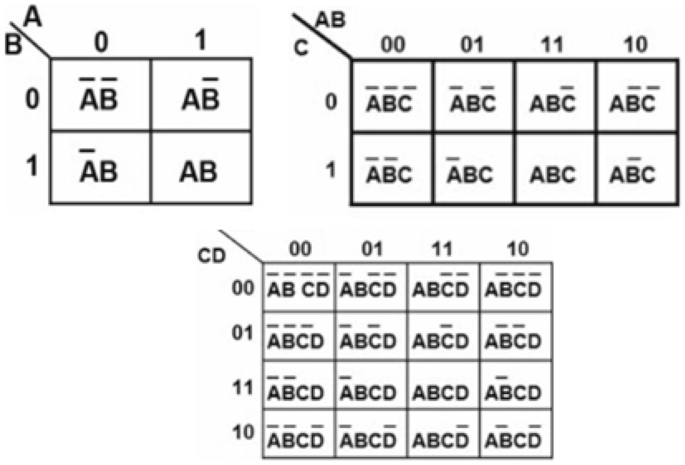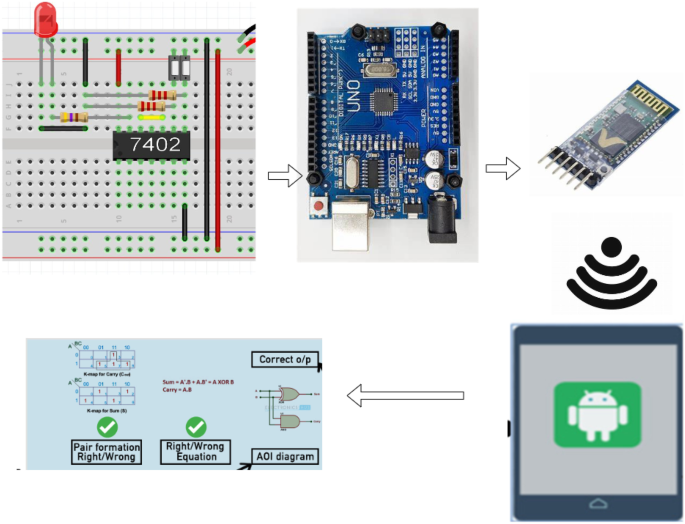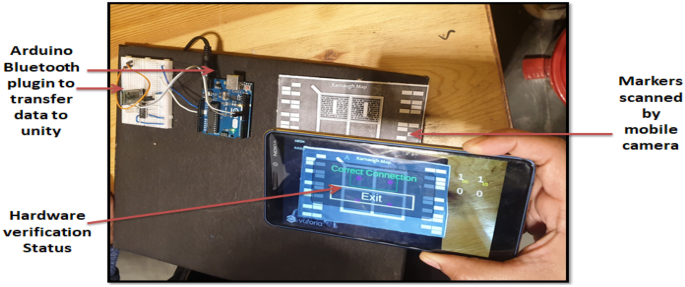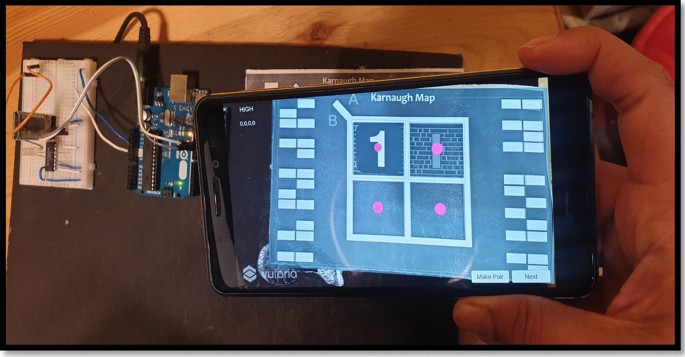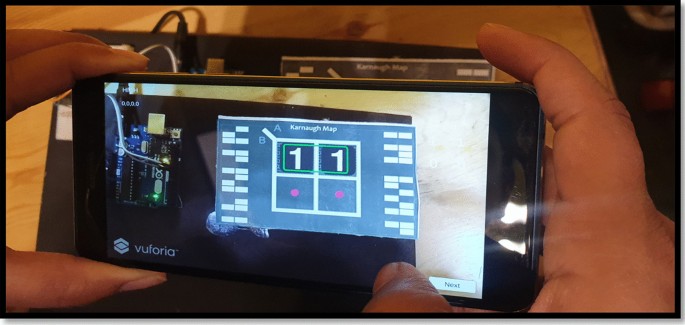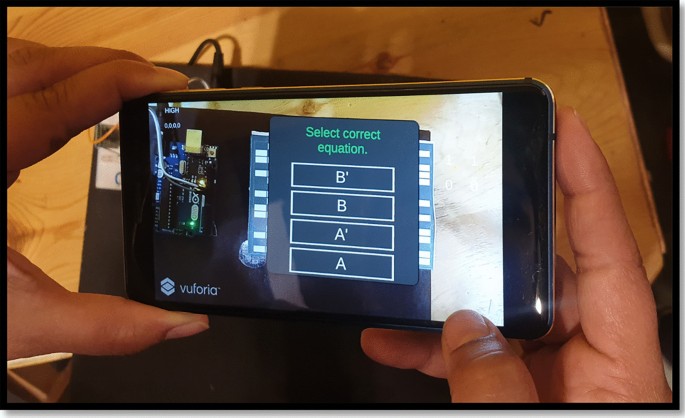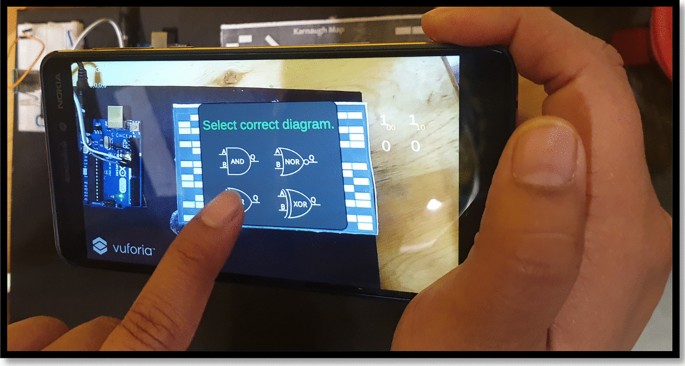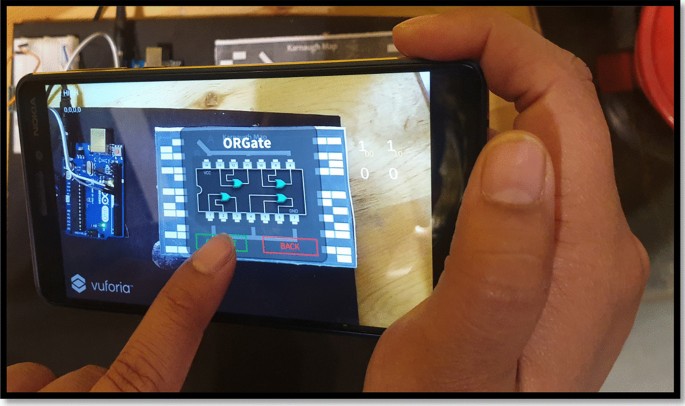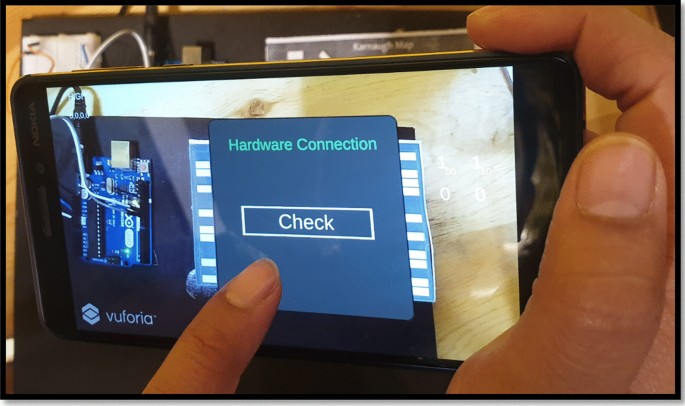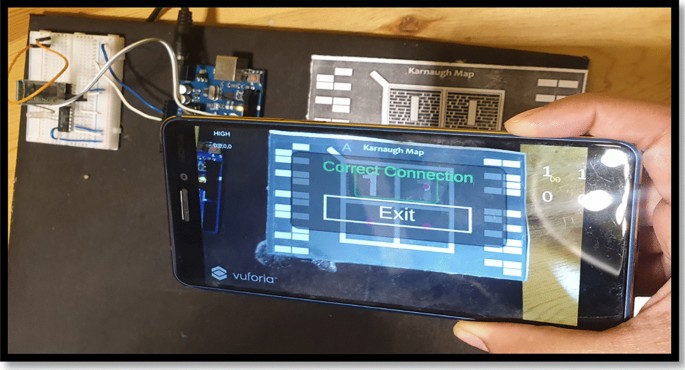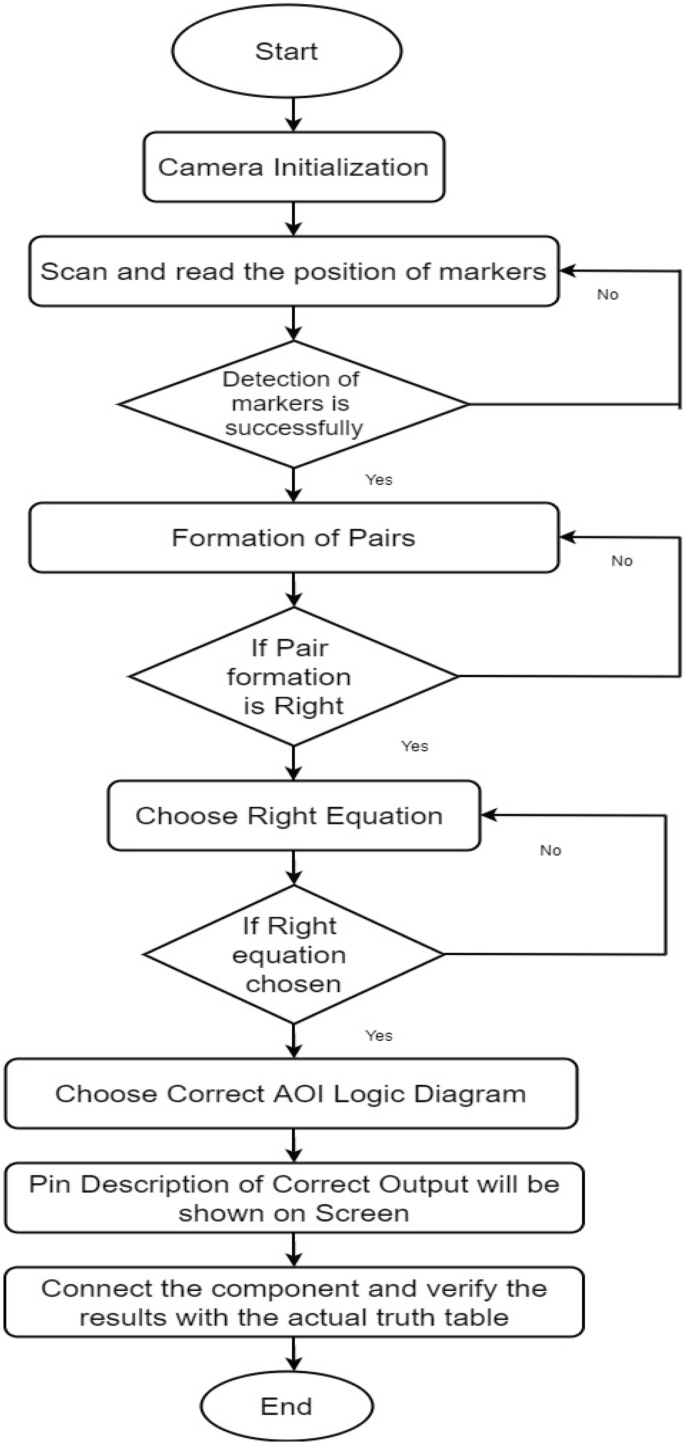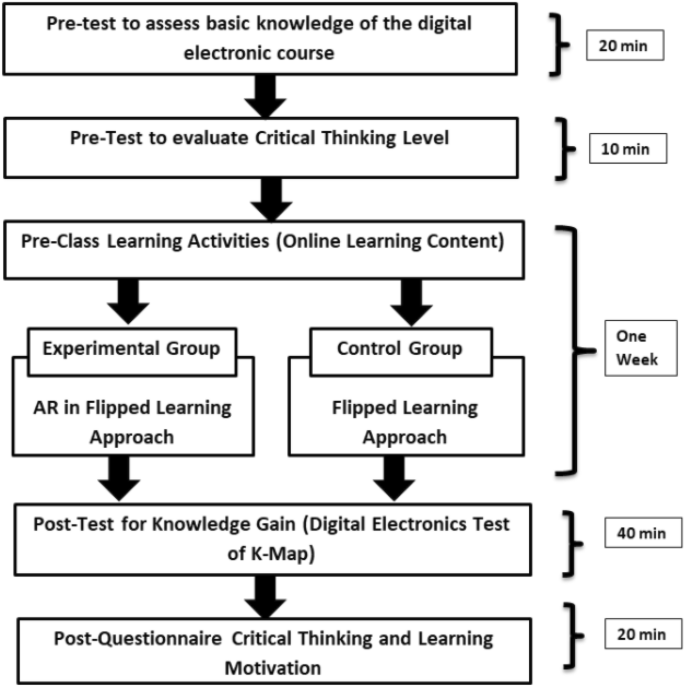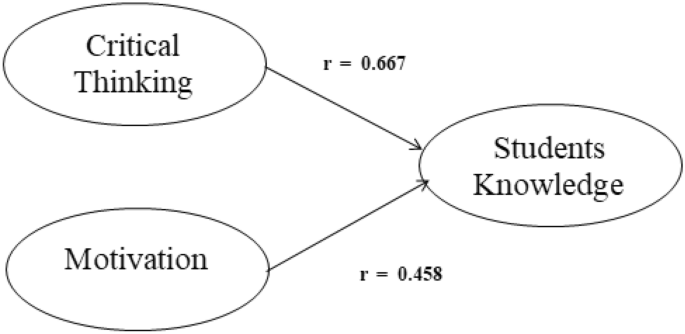Abstract
Digital electronics is a fundamental subject for engineering students, and it enables the students to learn design-based approaches and solve complex engineering problems. Students learn about minimization techniques for reducing the hardware components and size of the circuit by solving complex Boolean equations. The Karnaugh map (K-map) is one such technique utilized in digital electronics to solve complex Boolean equations and design AND-OR-INVERT (AOI) logical diagrams. The K-map technique involves several steps to solve the Boolean expression, and students often find it difficult to follow the K-map process. In this study, an AR-based learning system was developed using Unity 3D and Vuforia SDK that aimed to teach the students about the step-wise operation of the K-map technique. An experimental study was conducted with 128 undergraduate engineering students to determine the impact of the AR learning system on the critical thinking skills, learning motivation, and knowledge gain of students. The students were divided into two groups: experimental group (N = 64) and control group (N = 64). The AR learning system was implemented in flipped learning mode and utilized to provide in-class activities during the learning. The experimental group students utilized the AR learning system for in-class activities whereas control group students performed in-class activities using the traditional approach. The experimental outcomes indicate that the use of AR technology has a significant positive impact on the critical thinking skills, learning motivation, and knowledge gain of students. The study also found that critical thinking skills and learning motivation have a significant positive correlation with the knowledge gain of students in the experimental group.
Similar content being viewed by others
Avoid common mistakes on your manuscript.
Introduction
The policymakers and leaders of modern universities often find it difficult with the changing demands of the students in modern education setup (Liu & Chen Jan., 2018). Traditional teaching methods are not sufficient enough in providing better learning opportunities. The traditional teaching style exchanges information from textbooks with students, but should be applied to solving real-world problems (Bansal et al., 2020; Tadesse et al., 2019). Innovative learning methodologies are evolving, addressing the changing demands of education, and have the potential to improve the education system. Innovative techniques of teaching or learning that make use of cutting-edge technology are essential in the digital age. The modern education system is based on an interactive learning paradigm in which students learn through social networks, collaboration, immersion, think-pair-share, and information collection for self-exploration (Zainuddin & Perera Aug., 2017). Several learning methodologies, such as active learning, collaborative learning, cooperative learning, flipped learning, guided learning, peer evaluation, video sharing, synchronous sharing, inquiry-based learning, and contextual mobile learning, have been adopted by educators in recent times to enhance the learning (Chi et al., 2017; Lai & Hwang, 2015).
The Flipped Learning Approach (FLA) is a teaching methodology based on the “Inverted Classroom” principle. The FLA setting is the inverse of a regular classroom, which implies lectures are moved from the university classroom to students’ activities at home. The traditional teaching method emphasizes the “sage on the stage” where the teacher is focused on lecture delivery and the process is more teacher-oriented, whereas FLA emphasizes “guide by side” where the teacher’s role is of facilitator and guiding the students (Strayer Jul., 2012). FLA has four pillars: flexible environment, learning, instructional content, and professional educator (Sams et al., 2012). Bergman and Sams are the pioneers of the FLA approach. They recorded the lectures and posted them to the students who missed the class (Sams et al., 2012). They noticed that students who attend the class also take advantage of the recorded video lectures. As a result, they utilize lecture time on user interactions with the students. The FLA approach contains three essential elements: the creation of lecture videos, the planning of in-class activities, and evaluation. In the foremost step, the instructor prepares online videos and posts them to students through the university portal, email, YouTube channels, canvas, etc. Secondly, during class time, the instructor designs activities to interest the students, resulting in enhanced peer interaction. To assess the student’s performance, the instructor can create multiple-choice questions, short answer type questions, design-based problems, and rubrics, among other things.
In-class activities are of great importance for the effectiveness of the FLA because student learning is directly associated with the objectives of the learning activity. Technology intervention could affect to a greater extent enhancing student learning experience during in-class activities (Hwang et al., Dec. 2015). E-learning tools make use of animated images, web pages with text and images, and flash content (Malhotra & Verma, 2020). The content offered on these platforms is two-dimensional and lacks interactivity (Mejías Borrero & Andújar Márquez, 2012). Consequently, there is a need to incorporate interactive learning techniques so that effective learning can occur during class time. When the activity-based design is blended with interactive learning technology, it can significantly improve student abilities, knowledge, and motivation. Augmented reality technology can dynamically present the learning content and provide immersive learning to the students. AR overlays virtual objects in the real-world view with the help of computer graphics and image processing techniques (Yilmaz, 2016). It enables the users to interact with the virtual content which further enhances the user experience (Wang et al., Oct. 2018). AR has various applications in the field of military, education, entertainment, medicine, marketing, psychology, and advertisement (Azuma, 1997; Kesim & Ozarslan, 2012).
In this paper, AR technology is employed to develop a learning system that could help the students to learn about Karnaugh maps in electronics engineering. In electronics engineering, digital electronics is an important subject that deals with the design-based approach. In digital electronics, students learn about logic design and the basic organization of the circuits in digital devices. Students learn about minimization techniques for reducing the hardware components and size of the circuit by solving complex Boolean equations. The Karnaugh map (K-map) is one such technique utilized in digital electronics to solve complex Boolean equations and design AND-OR-INVERT (AOI) logical diagrams. The K-map technique involves several steps to solve the Boolean expression, and students often find it difficult to follow the K-map process. Also, while implementing the K-map technique, they make lots of errors that result in wrong logical solutions. So, there is a requirement for a learning environment where students follow the K-map steps to get the correct logical solutions. In this study, an AR-based learning environment was developed which aimed to address students’ problems while learning about K-map. The AR-based mobile application is an active-learning platform that provides step-wise operation of the K-map technique to students. While learning with the AR application, students get instant feedback about the logic design. They can interact with the application and develop an AOI logical diagram for any Boolean expression. The AR application was developed using the Unity3D game engine and can act as a self-guiding tool for individual learners. The main objective of this research study is to determine the impact of AR applications on the critical thinking skills, learning motivation, and knowledge of students in the flipped learning environment. Learning motivation relates to the desire of learners to learn and pick up new information, abilities, and attitudes. It motivates them to participate in pursuits that advance their intellectual, professional, and personal development. Critical thinking involves engaging in cognitive activities that require the use of mental processes, such as attention, selection, and judgment, to arrive at the most optimal solution. Students’ knowledge is not static and can be enhanced through various techniques, including training, practice, and experience. It is crucial to understand that everyone has different learning strengths and weaknesses and that some may do well in some subjects while others struggle. The following research questions were addressed in this study:
-
1.
How does the use of an AR learning system in flipped learning mode impact students’ critical thinking skills?
-
2.
How does the use of the AR learning system in flipped learning mode influence the learning motivation of students?
-
3.
How does the use of an AR learning system in flipped learning mode impact the student’s knowledge?
-
4.
What is the correlation between the critical thinking skills, learning motivation, and knowledge gain of students who learned using an AR learning system?
This paper is organized into the following sections: “Related Work” presents the related works, “AR Learning System” presents the development process of the AR learning environment, and “Methodology” presents the research methodology. Experimental analysis and results are presented in “Experimental Results.” “Discussion and Conclusion” presents the discussion and conclusion.
Related Work
According to the literature, AR-based applications enhance students’ learning abilities and learning outcomes by facilitating user engagement, providing direct input (particularly contextual information), and being enjoyable to use (Algayres & Triantafyllou, 2019)–[44]. Also, the use of AR in flipped learning mode enhances the instructional content in a significant way (Chen et al., 2017). Chang and Hwang (2018) proposed an AR-based flipped learning technique for school students and suggested that AR can improve the learning enthusiasm, satisfaction, ability to think objectively, self-efficacy, and cognitive load of students (Chang & Hwang Oct., 2018). Weinhandl et al. (2020) recommended that GeoGebra’s flipped learning approach helped strengthen students’ academic attitudes toward mathematical education. GeoGebra is an immersive framework of geometry primarily used to teach children in primary school (Weinhandl et al., 2020). Table 1 presents the use of AR applications in science education, language learning, and engineering education.
AR is an efficient learning technology as it utilizes class time effectively and provides an immersive experience to students. The combination of AR and flipped learning could be an efficient solution for both students and teachers, as it provides an interactive and engaging environment for the students.
Critical thinking is extremely important to Millennial learners, and it is often linked to other abilities such as metacognition, creative thinking, and intrinsic and extrinsic motivation. (Moeti et al., 2016). It has a strong relationship with the cognitive thinking of the students (analysis, synthesis, and evaluation) (Bloom et al., 1956). Most universities have embraced critical thinking skills as a real student-centered learning strategy, encouraging and guiding students to “how to think critically” (Anta & de Barrón, 2018). Tsui states critical thinking is highly related to instructional factors, which means the instructor should be aware of the needs of the students and accordingly adjust the teaching methodology (Tsui, 2002). Besides, an instructor must include in-class activities, research-oriented tasks, working in groups, and case studies, so that they critically analyze the solution to the problem and can discuss it with their peers. The use of AR in flipped learning mode can be a driving factor to influence the critical thinking, learning motivation, and knowledge of students.
AR Learning System
This section presents the steps involved in the design and development of the AR learning system. Figure 1 presents the different stages of implementation of the AR learning system in flipped learning mode.
Concept Formulation of AR learning system
The AR learning system is developed to enhance the critical thinking skills, learning motivation, and knowledge gain of students in digital electronics courses. The mobile AR application will act as a self-guiding tool that helps the students to learn through the blended learning environment. To develop the AR application, the learning objectives are defined to achieve the desired learning outcomes. The following are the learning objectives of the application:
-
LO1: To implement simple logical operations using combinational logic circuits.
-
LO2: To obtain a basic level of digital electronics knowledge and set the stage to perform the analysis and design of complex digital electronic circuits using K-map.
The Karnaugh map (K-map) is a minimization technique utilized in digital electronics to solve complex Boolean equations and design AND-OR-INVERT (AOI) logical diagrams. K-Map represents the pictorial view of the Boolean equations in tabular form. According to the binary input variables present in the equation, the size of the K-map varies. The following expression presents the relation between several input variables and the size of the K-map:
where n = number of input variables.
M = No. of cells in K-map (size of K-map).
Figure 2 presents the different K-maps for the number of input variables.
Design and Development of AR Learning System
The AR learning system uses a mobile AR application to teach the concept of K-map to engineering students and helps them to design the simplified circuit in a real-time scenario. The AR application will be used in a flipped learning mode where students watch videos and assess pre-learning material before the class and will use the AR learning system for in-class activities. In the present work, in-class activities to teach K-map are designed using AR technology. In the AR learning system, students can learn the steps of K-map simplifications: form the pairs, equate Boolean equations, and draw AOI logic diagrams. The system was developed using Unity 3D game engine and Vuforia SDK (Kumar et al., 2019; Kaur et al., 2063; Singh et al., 2019). The AR application will scan the paper markers using a mobile camera and allows the user to perform various tasks like binary-pair formation, selecting the right Boolean expressions, and building an AOI logic diagram.
An Arduino interface is also developed in the application for physical hardware circuit verification. The Arduino Uno is interfaced with the HC-05 Bluetooth module which will send the data to Unity 3D Bluetooth Plugin. The Arduino interface will verify the output of the designed circuit built on a breadboard and the Bluetooth module will send the information about the circuit’s correctness to the Unity 3D Bluetooth Plugin. The Unity 3D will display the message on the AR application as “Correct Connection” or “Incorrect Connection.” Fig. 3 represents the block diagram of the mobile AR application and the Arduino interface. Figure 4 presents the AR learning system.
Workflow of AR Learning System
This section presents the workflow of using the AR learning system for solving 2-variable Boolean expressions using K-map. The API of the developed AR application is shared with the students, and they were asked to install the application on their smartphones. After the installation of an AR application, students were given paper markers for the application along with the Arduino kit for physical hardware verification. An example of an OR gate (logic gate) is explained below to show the working of an AR learning system. Firstly, the truth table of an OR gate was posted by the teacher. According to the truth table, students were supposed to place the markers in the correct position.
Step 1: Place the markers as per the truth table mentioned and scan them through mobile cameras as shown in Fig. 5.
Steps 2 and 3: Populate the K-Map cells and form the pairs by clicking on the “Make Pair” tab as mentioned in Fig. 6.
Step 4: The equation screen mentioned in Fig. 7 appeared to the students only if the paired formation was correct, else the students had to form the pairs again.
Step 5: Once the correct equation was chosen then choose the correct AOI logic diagram as mentioned in Fig. 8.
Step 6: The internal structure of the logic gate appeared on the screen after choosing the AOI diagram, which helped the students to make OR gate connections in real time (with the help of IC 7432, breadboard, connecting wires, and LED as shown in Fig. 9).
Step 7: Once the student had made the connection (on a breadboard), then one question was expected to cross their minds, “whether the connections are correct or not?” The Arduino with Bluetooth plugin was used to transmit the real-time output to the unity application to answer this question. Students can verify the hardware connections by clicking on the “Check” button as given in Fig. 10.
Step 8: If the connections were correct, then the “correct connection” was displayed on the screen (as shown in step 8 of Fig. 11). Otherwise, “wrong connections” would appear on the screen. Figure 12 represents the graphical representation of the AR in the flipped learning system.
In this way, this self-guiding tool helped the students to learn and build a bridge between real and virtual environments through AR. With the help of this application, teachers could utilize more time on designing the applications related to K-map (which is a must for employability). Figure 12 represents the graphical workflow of the application.
Students could perform any activity related to the 2-variable on this learning platform. They had to place the markers according to the truth table, and they could design any logic gate (AND, OR, NOT, NAND, NOR, XOR, XNOR, etc.) on the learning platform. As students learned through brainstorming, it helped improve their critical thinking skills and understand complex topics through this application.
Methodology
An experimental study was conducted with engineering students to determine the impact of AR learning systems on the critical thinking skills, learning motivation, and knowledge gain of students. This section presents the participant details, experimental design, and measurement instruments of the study.
Participants
In the present work, a total of 128 s-year undergraduate students (mentioned in Table 2) from electronics engineering voluntarily participated in the study. The participants have no or very less knowledge of digital logic design using K-map. Also, they do not have any prior experience in learning AR technology. At the beginning of the experimental study, students were arbitrarily divided into two groups: the experimental group (N = 64) and the control group (N = 64). The random division of students was done by the other teacher who was not aware of the different interventions during the study. The experimental group was treated with an AR learning system in flipped learning mode, where students are provided with pre-class material in the form of videos to understand the basics of digital electronics. During class time, they are allowed to perform class activities with the help of the AR learning system. Whereas the students of the control group were treated using a conventional flipped learning approach, in which they are also provided with the same videos as pre-class material to learn at home, the control group students are allowed to perform in-class activities without the support of the AR learning system. Also, the students of both groups were facilitated by the same teacher having more than 10 years of teaching experience in electronics engineering.
Experimental Process
Initially, a pre-test was carried out with the students to evaluate their critical thinking ability and their knowledge about the subject before the experiment. After the pre-test, students were divided randomly into the experimental group (EG) and control group (CG). Students from the EG were taught using the AR learning system in a flipped learning mode, where they were allowed to watch videos as pre-class material and perform in-class activities using the AR learning system. The control group students were taught using the traditional flipped learning mode, in which they also watched the videos at home and performed the in-class activities using a standard laboratory manual. The teaching intervention for both groups was carried out for 1 week, and students learned about digital logic building using Karnaugh maps (K-maps). Students have applied the concept of K-maps to solve the digital logic building problems and designed the electronic circuit on the breadboard using logic gate ICs. Table 3 presents the details of the treatment given to both groups. The pre-class material is provided to the students in the form of videos using a “YouTube” channel named “Learn2Know”; students were instructed to watch the videos before attending the class. In-class activities are of great importance for improving the critical thinking skills of the students as they enable them to think critically, develop logic, and design electronic circuits. The in-class activities were designed to solve the application-based problem statements on digital electronics logic building. During the in-class activities, small groups of students were formed, nd they discussed their ideas with their peers and came up with optimized solutions. Activities were designed by keeping in mind the higher-order thinking level of Bloom’s taxonomy. The in-class activities enable the students to comprehend the facts, apply problem-solving strategies, think critically, infer from them, and then connect them to other concepts to achieve success. Appendix 1 provides information about the in-class activities. While conducting in-class activities, students of EG used the AR application for self-evaluation, whereas CG sought advice from the teacher. After the learning activity, a post-test was conducted to evaluate the knowledge of the two groups. Students were also asked to respond to the critical thinking and learning motivation questionnaire. The details of the experimental study are given in Fig. 13.
Measurement Tools
The questionnaire developed by Chai et al. (Sep. 2015) was modified and adapted to measure students’ critical thinking skills as mentioned in Appendix 2. It includes six items (e.g., “When using augmented reality-based flipped learning approach, I would think about what I have learned correctly” and “When doing augmented reality-based flipped learning approach, I will try to understand from different perspectives on what I have learned”). Students were asked to respond on a 5-point Likert scale. The Cronbach’s alpha of the survey questionnaire was 0.72 showing the internal consistency of the questionnaire. Appendix 2 presents the survey questionnaire used for evaluating the critical thinking skills of the students.
For measuring the learning motivation of students, a questionnaire designed by Keller (1987) was used. ARCS model is a student-centered model and consists of four elements: Attention, Relevance, Confidence, and Satisfaction. “Attention” deals with students’ interest in the lecture, “Relevance” relates to the content’s usefulness, “Confidence” deals with the belief of students, and “Satisfaction” relates directly to motivation. The questionnaire consisted of 36 open-ended questions, and students had to answer on a 5-point Likert scale. The Cronbach’s alpha for four elements of the ARCS model were the following: Attention = 0.821, Relevance = 0.709, Confidence = 0.719, and Satisfaction = 0.765, showing the reliability of the questionnaire.
A pre and post-test approach was used to measure the knowledge gained of the students for K-map. A subject expert having more than 10 years of teaching experience designed the knowledge test. The pre-test consisted of 20 multiple choice-based questions on digital electronics, and students were given 20 min to complete the test. The perfect score for the pre-test was 20. The post-test consisted of 15 multiple choice questions and five design-based questions on digital circuits. Students were given 40 min to complete the test, and the maximum score for the post-test was 30.
Experimental Results
RQ1: How Does the Use of AR Learning Systems in Flipped Learning Mode Impact Students’ Critical Thinking Skills?
To assess the difference in critical thinking skills of both groups before the learning activity, the pre-test was conducted. As shown in Table 4, the results indicated that there is no significant difference in the mean values of pre-test scores for the experimental group and control group. To evaluate the impact of AR intervention on critical thinking skills, the analysis of covariance (ANCOVA) test was applied to post-test scores. In ANCOVA analysis of post-test scores, the pre-test scores of critical thinking are considered as a control variable. Table 5 presented the post-test score. The mean value of critical thinking skills of the experimental group was 4.17 and for the control group was 3.41. F = 41.43, with a p-value less than 0.01 indicating a significant difference in the critical thinking abilities of both groups. The ANCOVA test analysis showed that the use of AR technology had a significant positive influence on students’ critical thinking skills. The η2 value is 0.405, which reflects a moderate effect size.
RQ2:How Does the Use of AR Learning Systems in Flipped Learning Mode Impact the Student’s Knowledge?
Before applying the analysis of covariance (ANCOVA) test, the students’ prior knowledge of the subject was assessed using the pre-test scores of the two groups. Table 6 shows a p-value larger than 0.05, indicating no significant difference in students’ knowledge prior to the learning activity. So, the ANCOVA test could be used to examine the post-test scores of the knowledge test. In ANCOVA analysis of post-test scores of knowledge gain, the pre-test scores of students’ knowledge are considered as a control variable.
Table 7 presents the ANCOVA analysis of post-test scores of knowledge gain. The mean value of the post-test score of the experimental group was 25.06 with an S.D. of 2.87, and the mean value of the control group was 19.56 with an S.D. of 3.04. F = 53.74 and a p-value less than 0.001 indicated a significant difference in the knowledge gain of the two groups. The ANCOVA analysis suggests that the students of the experimental group performed better in the post-test compared to the students of the control group. So, the AR intervention has a significant positive impact on the knowledge gain of students. The η2 value was 0.468, which showed a moderate effect size.
RQ3: How Does the Use of the AR Learning System in Flipped Learning Mode Influence the Learning Motivation of Students?
An independent sample t-test was conducted to determine the difference in the learning motivation of the two groups. Table 8 presents the t-test statistics for the four factors of the ARCS model: attention, relevance, confidence, and satisfaction. The overall mean value of ARCS for the experimental group was 4.66 and for the control group was 4.25, with a p-value < 0.01 which indicates that there is a significant difference in the learning motivation of the two groups. The experimental outcomes indicate that the students who learned with AR application were highly motivated compared to the control group students.
In terms of sub-scales of ARCS model, the mean score of attention of the experimental group was 4.70, and that for the control group was 4.18 with a p-value < 0.01. This suggests that AR intervention had a significant positive impact on student’s attention during learning. This could be because AR provided 3D representations of virtual objects, which raised students’ attention while learning. In terms of relevance, there was no significant difference between the two groups. Relevance refers to the alignment of instructional content towards the learning objectives. During the learning process, the instructional content of both teaching methodologies was aligned with the learning objectives. For confidence, the mean scores of the experimental and control groups were 4.75 and 4.10, with a p-value < 0.01 indicating that students of the experimental group were confident as compared to the control group students. The possible reason could be learning through interactive media, which stimulates curiosity in the students. It also simplifies the complex logic for a better understanding of the subject. For satisfaction, the mean scores for the experimental and control groups were 4.57 and 4.07, with a p-value < 0.01 indicating that students of the experimental group were delighted as compared to the control group students.
RQ4: What Is the Correlation Between the Critical Thinking Skills, Learning Motivation, and Knowledge Gain of Students Who Learned Using an AR Learning System?
To evaluate the correlation between critical thinking skills, learning motivation (ARCS), and knowledge gain of students in the experimental group, the Pearson correlation was used. Table 9 presents the Pearson correlation statistics. With r = 0.667 and p < 0.01, it indicates that the student’s critical thinking skills have a strong positive correlation with the knowledge gain of the students who learned with the AR application. Also, a moderate positive correlation was noticed between the learning motivation and knowledge gain of the students (r = 0.458, p < 0.01). It can be concluded that the use of AR technology in flipped learning mode enhances the student’s learning experience, learning motivation, and critical thinking skills. Critical thinking skills and learning motivation have a significant positive correlation with the knowledge gain of students in the experimental group as given in Fig. 14.
Table 10 compares how different fields are using augmented reality technology in terms of attention, relevance, confidence, and satisfaction.
Discussion and Conclusion
In this study, a hybrid learning framework was proposed to integrate the flipped learning approach with AR technological design to provide unique and compelling learning experiences to engineering students. The AR-based flipped learning approach allowed utilizing the classroom time better by providing interactive and immersive learning to the students, which actively involved the learners in the learning process. An AR learning system was developed so that actual learning took place at an individual level and thus transformed the learning into activity-based and problem-solving learning. The AR learning system was designed using the Unity3D game engine and Vuforia SDK. An experimental study was conducted with engineering students to determine the effectiveness of the proposed system on students’ knowledge, critical thinking skills, and learning motivation in digital electronics course. The experimental outcomes indicated that the AR in flipped learning mode significantly improved the students’ knowledge, critical thinking skills, and learning motivation compared to the conventional teaching methods. The experimental results substantiated several previous studies that exhibited the impact of AR intervention on student learning and critical thinking skills.
The study presented the use of AR technology in flipped learning mode. It indicated improved students’ critical thinking skills through enhanced engagement and better visualization of discrete concepts of digital electronics. The mean value of the post-test score of critical thinking for the experimental group was 4.13 compared to 3.31 for the control group, which implied a significant improvement in the critical thinking skills of the experimental group. The study’s findings support the findings of Chang and Hwang (2018), who proved that AR technology with a flipped guiding approach helps to improve critical thinking, self-efficacy, and motivation of the learners (Chang & Hwang Oct., 2018). It also supports the findings of Sailer and Sailer (2021) and Gomez et al. (2020) who proved that incorporating gamification in flipped classroom setting enhances the competency skills among the students and make them better problem solvers (Gómez-Carrasco et al., 2020; Sailer & Sailer, 2021).
The outcome of the present research work also supports the result of Algayres (Algayres & Triantafyllou, 2019), which states that combining game-based learning with the flipped classroom methodology can improve student motivation, learning outcomes, and engagement. In other words, if the classroom environment is more stimulating, students are more likely to participate in in-class activities and think critically about the assigned problem statement (Algayres & Triantafyllou, 2019). These reviews correspond to the present study’s findings, which suggest that effectively blending AR technology with flipped learning can enhance students’ critical thinking abilities, especially during in-class activities wherein students are more challenged with more probing questions. The possible reason for the positive effect of AR with flipped learning on critical thinking is its learner-centered approach. In learner-centered approach, learners think critically, interpret, analyze, and solve design-based problems by interacting with peers during class activities. Another reason could be the MAR application’s immersive and engaging environment, which provides better visualization of digital electronics concepts. The MAR application also acts as a self-evaluating tool that allows the students to check their solutions for the design problems. In addition, discussion in the classroom and solving design problems may have assisted students. It allowed them to understand the design problems and think from different perspectives. Flipped learning also allows the students to present their knowledge in front of the class, and peers will enable them to receive feedback. Walker also proves that instructions that emphasize student discussions could help improve critical thinking (Walker, 2012).
To evaluate students’ learning motivation during the experimental study, the adapted ARCS model consisted of four elements: attention, relevance, confidence, and satisfaction. The overall mean score was 4.51 of the experimental group and 4.10 of the control group proving a significant difference in the learning motivation of the two students. The experimental outcomes showed that the experimental group students were highly motivated compared to the control group students. During the learning process, teachers observed that students of the AR in flipped learning group were excited and curious to use the AR application. The experimental results showed that attention, confidence, and satisfaction were the relevant elements that enhanced the student learning motivations. The following could be the possible reasons for the enhanced learning motivation of students. First, the proposed AR system allowed the students to interact with and manipulate the 3D virtual content that enhanced their attention and interest during the learning process. Second, the AR in flipped learning provided instant feedback on their logic designs which helped them learn independently and establish independent learning abilities. Third, the students had access to the AR application anywhere and anytime, giving them the flexibility to learn and stimulating active learning.
In terms of knowledge gain, the mean score of the post-test for the experimental group was 22.88. The control group was 19.19 with a p-value < 0.01 that showed a significant positive impact of AR intervention on students’ knowledge gain. The use of the proposed AR application provided feedback to the students at every step about their logic that allowed them to practice more independently and significantly enhanced their skills in designing digital circuits. Compared to the conventional flipped learning approach, the AR in flipped learning approach also provided an effective self-learning model to the students and encouraged them to learn actively through their individualistic observation. The one limitation of the proposed system is that it requires a good-resolution camera. Sometimes, there is a problem in detecting markers when using a low-resolution camera. In this study, we have used android smartphones with HD resolution.
To summarize, this research involved the creation of an AR-based learning system using Unity 3D and Vuforia SDK, which aimed to teach undergraduate engineering students about the step-by-step operation of the K-map technique. The effectiveness of this system on the students’ critical thinking skills, learning motivation, and knowledge gain was tested through an experimental study with 128 participants. The students were divided into two groups: an experimental group (N = 64) and a control group (N = 64). The AR learning system was implemented in flipped learning mode and used for in-class activities in the experimental group, while the control group used the traditional approach. The results showed that the use of AR technology had a significant positive impact on the critical thinking skills, learning motivation, and knowledge gain of students in the experimental group. Additionally, the study found a significant positive correlation between critical thinking skills, learning motivation, and knowledge gain in the experimental group. During the COVID-19 pandemic, conventional teaching methods considerably failed to provide an interactive learning experience to students due to a lack of active engagement. The utilization of disruptive technologies like AR and VR can provide unique learning experiences to the students. Immersion is an essential feature of AR and VR technology that can impart better visualization and critical thinking skills.
The present study has a some limitation in terms of self-rating scales of critical thinking and learning motivation. Using the self-rating scales may cause self-bias by the respondant and may lack of accuracy (Dang et al., 2020). Overall, self-rating should not be the only way to evaluate learning, even though it can be a helpful tool for getting students to think critically about their education and take ownership of their development. To provide a more thorough view of student learning and performance, teachers should also use additional forms of assessment, such as peer evaluations, teacher feedback, and standardized tests in the future research work.
Availability of data and materials
Yes.
References
Algayres, M., & Triantafyllou, E. (2019). Combining game-based learning and the flipped classroom: a scoping review, in Proceedings of the 12th European Conference on Game Based Learning, p. 97.
Azuma, R. T. (1997). A survey of augmented reality. Presence Teleoperators Virtual Environ., 6(4), 355–385.
Bansal, K., Tandon, U., Bhandari, H., & Mittal, A. (2020). Identifying the drivers in the adoption of technology in online teaching, learning and assessment of an undergraduate architectural program. 2020 Sixth International Conference on e-Learning (econf), pp. 40–44.
Bezanilla, M. J., Fernández-Nogueira, D., Poblete, M., & Galindo-Domínguez, H. (2019). Methodologies for teaching-learning critical thinking in higher education: the teacher’s view. Thinking skills and creativity, 33, 100584.
Bloom, B. S., Engelhart, M. D., Furst, E. J., Hill, W. H., & Krathwohl, D. R. (1956). The classification of educational goals. Taxonomy of Educational Objectives, 207.
Chai, C. S., Deng, F., Tsai, P., Koh, J. H. L., & Tsai, C. -C. (2015). Assessing multidimensional students’ perceptions of twenty-first-century learning practices. Asia Pacific Education Review, 16(3), 389–398.
Chang, S. -C., & Hwang, G. -J. (2018). Impacts of an augmented reality-based flipped learning guiding approach on students’ scientific project performance and perceptions. Computers & Education, 125, 226–239.
Chen, P., Liu, X., Cheng, W., & Huang, R. (2017). Innovations in smart learning. Singapore.
Chi, Y. L., Chen, T. Y., & Hung, C. (2017). Learning adaptivity in support of flipped learning: an ontological problem-solving approach. ChemElectroChem, pp. 1–14.
Dang, J., King, K. M., & Inzlicht, M. (2020). Why are self-report and behavioral measures weakly correlated? Trends in Cognitive Sciences, 24(4), 267–269.
Faridi, H., Tuli, N., Mantri, A., Singh, G., & Gargrish, S. (2020). A framework utilizing augmented reality to improve critical thinking ability and learning gain of the students in Physics. Computer Applications in Engineering Education.
Gómez-Carrasco, C. J., Monteagudo-Fernández, J., Moreno-Vera, J. R., & Sainz-Gómez, M. (2020). Evaluation of a gamification and flipped-classroom program used in teacher training: perception of learning and outcome, PLoS One, 15(7), 1–19.
Hwang, G.-J., Lai, C.-L., & Wang, S.-Y. (2015). Seamless flipped learning: A mobile technology-enhanced flipped classroom with effective learning strategies. Journal of Computers in Education, 2(4), 449–473.
Ibáñez, M. B., Portillo, A. U., Cabada, R. Z., & Barrón, M. L. (2020). Impact of augmented reality technology on academic achievement and motivation of students from public and private Mexican schools. A case study in a middle-school geometry course. Computers & Education, 145, 103734.
Kaur, D. P., Mantri, A., & Horan, B. (2018). A framework utilizing augmented reality to enhance the teaching–learning experience of linear control systems. IETE Journal of Research, 2063.
Keller, J. M. (1987). Development and use of the ARCS model of motivational design. Journal of Instructional Development, 10(1932), 2–10.
Kesim, M., & Ozarslan, Y. (2012). Augmented reality in education: Current technologies and the potential for education. Procedia - Social and Behavioral Sciences, 47(222), 297–302.
Kumar, A., Mantri, A., & Dutta, R. (2020). Development of an augmented reality‐based scaffold to improve the learning experience of engineering students in embedded system course. Computer Applications in Engineering Education, p. cae.22245.
Lai, C. L., & Hwang, G. J. (2015). High school teachers’ perspectives on applying different mobile learning strategies to science courses: The national mobile learning program in Taiwan. International Journal of Mobile Learning and Organisation, 9(2), 124–145.
Liu, X., & Chen, X. (2018). Disruptive technology enhanced learning: The use and misuse of digital technologies in higher education. Innovations in Education and Teaching International, 55(1), 119–120.
Malhotra, R., & Verma, N. (2020). An impact of using multimedia presentations on engineering education. Procedia Computer Science, 172, 71–76.
Massa, S. (2014). The development of critical thinking in primary school: The role of teachers’ beliefs. Procedia - Social and Behavioral Sciences, 141(April), 387–392.
Mejías Borrero, A., & Andújar Márquez, J. M. (2012). A pilot study of the effectiveness of augmented reality to enhance the use of remote labs in electrical engineering education. Journal of Science Education and Technology, 21(5), 540–557.
Moeti, B., Killion Mgawi, R., & Smitta Moalosi, W. T. (2016). Critical thinking among post-graduate diploma in education students in higher education: reality or fuss?. Journal of Education and Learning, 6(2), 13.
Mylonas, G., Triantafyllis, C., & Amaxilatis, D. (2019). An augmented reality prototype for supporting IoT-based educational activities for energy-efficient school buildings. Electronic Notes in Theoretical Computer Science, 343, 89–101.
Özüağ, M., Cantürk, İ., & Özyilmaz, L. (2019). A new perspective to electrical circuit simulation with augmented reality. International Journal of Electrical and Electronic Engineering & Telecommunications, 8(1), 9–13.
Sailer, M., & Sailer, M. (2021). Gamification of in-class activities in flipped classroom lectures. British Journal of Educational Technology, 52(1), 75–90.
Sams, A., & Washington, O. (2012). Jonathan Bergmann.
Singh, G., Mantri, A., Sharma, O., Dutta, R., & Kaur, R. (2019). Evaluating the impact of the augmented reality learning environment on electronics laboratory skills of engineering students. Computer Applications in Engineering Education, 27(6), 1361–1375.
Strayer, J. F. (2012). How learning in an inverted classroom influences cooperation, innovation and task orientation. Learning Environments Research, 15(2), 171–193.
Tadesse, T., Gillies, R. M., & Manathunga, C. (2020). Shifting the instructional paradigm in higher education classrooms in Ethiopia: what happens when we use cooperative learning pedagogies more seriously?. International Journal of Educational Research, 99, p. 101509.
Tsui, L. (2002). Fostering critical thinking through effective pedagogy: Evidence from four institutional case studies. The journal of higher education, 73(6), 740-763.
Walker, D.-M. (2012). Classroom assessment techniques: An assessment and student evaluation method. Creative Education, 03(06), 903–907.
Wang, M., Callaghan, V., Bernhardt, J., White, K., & Peña-Rios, A. (2018). Augmented reality in education and training: Pedagogical approaches and illustrative case studies. Journal of Ambient Intelligence and Humanized Computing, 9(5), 1391–1402.
Weinhandl, R., Lavicza, Z., Hohenwarter, M., & Schallert, S. (2020). Enhancing flipped mathematics education by utilising GeoGebra. International Journal of Education in Mathematics, Science and Technology, 8(1), 1–15.
Yilmaz, R. M. (2018). Augmented reality trends in education between 2016 and 2017 years. State Art Virtual Real Augment Real Knowhow.
Zainuddin, Z., & Perera, C. J. (2017). Exploring students’ competence, autonomy and relatedness in the flipped classroom pedagogical model. Journal of Further and Higher Education, 43(1), 1–12.
Zelaieta Anta, E., & Camino Ortiz de Barrón, I. (2018), El desarrollo del pensamiento crítico en la formación inicial del profesorado: análisis de una estrategia pedagógica desde la visión del alumnado. Profesorado Rev Currículum y Form del Profr, 22(1), 197–214.
Funding
NA.
Author information
Authors and Affiliations
Contributions
Under the supervision of Dr. Archana Mantri and Dr. Gurjinder Singh, the experimental study was conducted and implemented by Dr. Rubina Dutta. Mr. Narinder Pal Singh provides thhe technical support to develop mobile application.
Corresponding author
Ethics declarations
Ethics Approval
Yes.
Informed Consent
Yes.
Statement Regarding Research Involving Human Participants and/or Animals
NA.
Consent to Participate
Yes.
Consent to Publish
Yes.
Competing Interests
The authors declare no competing interests.
Additional information
Publisher's Note
Springer Nature remains neutral with regard to jurisdictional claims in published maps and institutional affiliations.
Rights and permissions
Springer Nature or its licensor (e.g. a society or other partner) holds exclusive rights to this article under a publishing agreement with the author(s) or other rightsholder(s); author self-archiving of the accepted manuscript version of this article is solely governed by the terms of such publishing agreement and applicable law.
About this article
Cite this article
Dutta, R., Mantri, A., Singh, G. et al. Measuring the Impact of Augmented Reality in Flipped Learning Mode on Critical Thinking, Learning Motivation, and Knowledge of Engineering Students. J Sci Educ Technol 32, 912–930 (2023). https://doi.org/10.1007/s10956-023-10051-2
Accepted:
Published:
Issue Date:
DOI: https://doi.org/10.1007/s10956-023-10051-2






